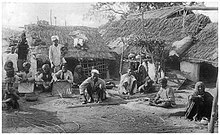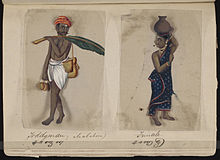The Basor weaving bamboo baskets in a 1916 book. The Basor are a Scheduled Caste found in the state of Uttar Pradesh in India.
Caste is a form of social stratification characterized by endogamy,
hereditary transmission of a style of life which often includes an
occupation, ritual status in a hierarchy, and customary social
interaction and exclusion based on cultural notions of purity and
pollution. Its paradigmatic ethnographic example is the division of India's Hindu society into rigid social groups, with roots in India's ancient history and persisting to the present time. However, the economic significance of the caste system in India
has been declining as a result of urbanization and affirmative action
programs. A subject of much scholarship by sociologists and
anthropologists, the Hindu caste system is sometimes used as an
analogical basis for the study of caste-like social divisions existing
outside Hinduism and India. The term "caste" is also applied to
morphological groupings in female populations of ants and bees.
Etymology
The English word "caste" derives from the Spanish and Portuguese casta, which, according to the John Minsheu's Spanish dictionary (1569), means "race, lineage, tribe or breed". When the Spanish colonized the New World, they used the word to mean a "clan or lineage". It was, however, the Portuguese who first employed casta
in the primary modern sense of the English word 'caste' when they
applied it to the thousands of endogamous, hereditary Indian social
groups they encountered upon their arrival in India in 1498. The use of the spelling "caste", with this latter meaning, is first attested in English in 1613.
Caste system in India
Modern India's caste system is based on the colonial superimposition
of the Portuguese word “casta” on the four-fold theoretical
classification called Varna and on natural social groupings called Jāti. From 1901 onwards, for the purposes of the Decennial Census, the British classified all Jātis into one or the other of the Varna
categories as described in ancient texts. Herbert Hope Risley, the
Census Commissioner, noted that "The principle suggested as a basis was
that of classification by social precedence as recognized by native
public opinion at the present day, and manifesting itself in the facts
that particular castes are supposed to be the modern representatives of
one or other of the castes of the theoretical Indian system."
Varna, as mentioned in ancient Hindu texts, describes society as divided into four categories: Brahmins (scholars and yajna priests), Kshatriyas (rulers and warriors), Vaishyas (farmers, merchants and artisans) and Shudras (workmen/service providers). The texts do not mention any hierarchy or a separate, untouchable category in Varna classification. Scholars believe that the Varnas
system was never truly operational in society and there is no evidence
of it ever being a reality in Indian history. The practical division of
the society had always been in terms of Jātis (birth groups),
which are not based on any specific religious principle, but could vary
from ethnic origins to occupations to geographic areas. The Jātis
have been endogamous social groups without any fixed hierarchy but
subject to vague notions of rank articulated over time based on
lifestyle and social, political or economic status. Many of India's
major empires and dynasties like the Mauryas, Shalivahanas, Chalukyas, Kakatiyas among many others, were founded by people who would have been classified as Shudras, under the Varnas
system. It is well established that by the 9th century, kings from all
the four Varnas, including Brahmins and Vaishyas, had occupied the
highest seat in the monarchical system in Hindu India, contrary to the
Varna theory.
In many instances, as in Bengal, historically the kings and rulers had
been called upon, when required, to mediate on the ranks of Jātis, which might number in thousands all over the subcontinent and vary by region. In practice, the jātis may or may not fit into the Varna classes and many prominent Jatis, for example the Jats and Yadavs, straddled two Varnas i.e. Kshatriyas and Vaishyas, and the Varna status of Jātis itself was subject to articulation over time.
Starting with the British colonial Census of 1901 led by Herbert Hope Risley, all the jātis were grouped under the theoretical varnas categories. According to political scientist Lloyd Rudolph, Risley believed that varna,
however ancient, could be applied to all the modern castes found in
India, and "[he] meant to identify and place several hundred million
Indians within it."
In an effort to arrange various castes in order of precedence
functional grouping was based less on the occupation that prevailed in
each case in the present day than on that which was traditional with it,
or which gave rise to its differentiation from the rest of the
community. "This action virtually removed Indians from the progress of
history and condemned them to an unchanging position and place in time.
In one sense, it is rather ironic that the British, who continually
accused the Indian people of having a static society, should then impose
a construct that denied progress" The terms varna (conceptual classification based on occupation) and jāti (groups) are two distinct concepts: while varna is a theoretical four-part division, jāti
(community) refers to the thousands of actual endogamous social groups
prevalent across the subcontinent. The classical authors scarcely speak
of anything other than the varnas, as it provided a convenient shorthand; but a problem arises when colonial Indologists sometimes confuse the two.
Thus, starting with the 1901 Census, caste officially became India's
essential institution, with an imprimatur from the British
administrators, augmenting a discourse that had already dominated
Indology. “Despite India's acquisition of formal political independence,
it has still not regained the power to know its own past and present
apart from that discourse”.
An image of a man and woman from the toddy-tapping community in Malabar from the manuscript Seventy-two Specimens of Castes in India,
which consists of 72 full-color hand-painted images of men and women of
various religions, occupations and ethnic groups found in Madura, India
in 1837, which confirms the popular perception and nature of caste as
Jati, before the British made it applicable only to Hindus grouped under
the varna categories from the 1901 census onwards.
Upon independence from Britain, the Indian Constitution listed 1,108
castes across the country as Scheduled Castes in 1950, for positive
discrimination. The Untouchable communities are sometimes called Scheduled Castes, Dalit or Harijan in contemporary literature. In 2001, Dalits were 16.2% of India's population. Most of the 15 million bonded child workers are from the lowest castes. Independent India has witnessed caste-related violence. In 2005, government recorded approximately 110,000 cases of reported violent acts, including rape and murder, against Dalits. For 2012, the government recorded 651 murders, 3,855 injuries, 1,576 rapes, 490 kidnappings, and 214 cases of arson.
The socio-economic limitations of the caste system are reduced due to urbanization and affirmative action. Nevertheless, the caste system still exists in endogamy and patrimony,
and thrives in the politics of democracy, where caste provides ready
made constituencies to politicians. The globalization and economic
opportunities from foreign businesses has influenced the growth of
India's middle-class population. Some members of the Chhattisgarh Potter
Caste Community (CPCC) are middle-class urban professionals and no
longer potters unlike the remaining majority of traditional rural potter
members. There is persistence of caste in Indian politics. Caste
associations have evolved into caste-based political parties. Political
parties and the state perceive caste as an important factor for
mobilization of people and policy development.
Studies by Bhatt and Beteille have shown changes in status,
openness, mobility in the social aspects of Indian society. As a result
of modern socio-economic changes in the country, India is experiencing
significant changes in the dynamics And the economics of its social
sphere.
While arranged marriages are still the most common practice in India,
the internet has provided a network for younger Indians to take control
of their relationships through the use of dating apps. This remains
isolated to informal terms, as marriage is not often achieved through
the use of these apps.
Hypergamy is still a common practice in India and Hindu culture. Men
are expected to marry within their caste, or one below, with no social
repercussions. If a woman marries into a higher caste, then her children
will take the status of their father. If she marries down, her family
is reduced to the social status of their son in law. In this case, the
women are bearers of the egalitarian principle of the marriage. There
would be no benefit in marrying a higher caste if the terms of the
marriage did not imply equality. However, men are systematically shielded from the negative implications of the agreement.
Geographical factors also determine adherence to the caste
system. Many Northern villages are more likely to participate in
exogamous marriage, due to a lack of eligible suitors within the same
caste. Women in North India have been found to be less likely to leave
or divorce their husbands since they are of a relatively lower caste
system, and have higher restrictions on their freedoms. On the other
hand, Pahari women, of the northern mountains, have much more freedom to
leave their husbands without stigma. This often leads to better
husbandry as his actions are not protected by social expectations.
Chiefly among the factors influencing the rise of exogamy is the rapid urbanisation in India
experienced over the last century. It is well known that urban centers
tend to be less reliant on agriculture and are more progressive as a
whole. As India’s cities boomed in population, the job market grew to
keep pace. Prosperity and stability were now more easily attained by an
individual, and the anxiety to marry quickly and effectively was
reduced. Thus, younger, more progressive generations of urban Indians
are less likely than ever to participate in the antiquated system of
arranged endogamy.
India has also implemented a form of Affirmative Action, locally
known as “reservation groups”. Quota system jobs, as well as placements
in publicly funded colleges, hold spots for the 8% of India’s minority,
and underprivileged groups. As a result, in states such as Tamil Nadu or
those in the north-east, where underprivileged populations predominate,
over 80% of government jobs are set aside in quotas. In education,
colleges lower the marks necessary for the Dalits to enter.


